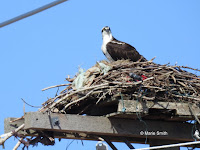CONSERVATION
For information specific to Conservation in Hawaii, please check this page.
Bird Conservation has become an important issue as we realize the impact of various factors (for example, habitat encroachment from development) on bird populations. It is so important that it has become part of the science of Conservation Biology.
 |
| This Tree swallow is sending a message photo by Matt Beardsley, PEI, Canada |
For seabirds: fishing gear, oil spills, plastic in the ocean;
For ground-nesting birds: cats, dogs, rats, possums;
For native birds: introduced species;
For birds of prey: ammunition containing lead;
For migrating birds: poisoned bodies of water from pollution along their migratory routes; collisions with windows of high-rise buildings; collisions with aircraft;
For field birds: agricultural practices;
For various species: hunting for the birds’ feathers or their meat, sometimes to extinction; plain vandalism; garbage.
Plastic pollution in the ocean – One example: the Hawaiian Islands are located in the middle of the North Pacific Gyre. This word means ‘rotating’. This is where the ‘Great Pacific Garbage Patch‘ (or ‘Pacific Trash Vortex’) is located.)
This vast ocean current gathers garbage in its middle, which means that pristine beaches in Hawaii are polluted with all kinds of microscopic and larger floating debris, much of it plastic and styrofoam. Studies have shown that seabirds such as the Laysan Albatross ingest a large amount of those debris, which can stay in their stomach and cause lacerations and other problems. The birds also unfortunately feed those debris to their chicks as well.
 |
| Northern fulmar, Salko de Wolf, Ecomare |
 |
| Plastic found inside dead Northern fulmar photo by Dr. Carol Meteyer, USFSW |
Lead poisoning in Birds of prey from gun ammo: another issue related to lead poisoning is occurring in birds of prey which ingest lead from gun ammo used to kill ducks for example. Hunters are being encouraged to switch to non-lead ammunition to protect birds of prey.
Migratory Bird Collisions: There are now widespread ‘Lights Out’ programs in the USA and Canada to encourage, even mandate, cities to turn off building lights at night to prevent migratory bird collisions in the spring (numbers vary from 100 million to 1 billion migrating birds each year in North America). Small song birds are especially vulnerable.
CHARGES: Sometimes charges are laid against polluters for the consequences on birds.
 |
| Oiled Surf scoter, by |
COSEWIC: The Committee on the Status of Endangered Wildlife in Canada is a federal government funded group of scientists who track Canadian wildlife for the health of their population. Their website is a precious source of information.
Habitat preservation initiative:
One example of a habitat preservation initiative in the wintering areas of North American songbirds is the modification of farming practices of coffee growers, mainly in Central America. Those species are called the ‘coffee bird’ group. Measures are now being taken to preserve the habitat of those species of birds with more sustainable coffee growing practices while still preserving profitability for the farmers.
www.borealbirds.org is an initiative to protect the boreal forest for breeding birds.
Another example of habitat preservation is avoiding the trimming of trees when birds nest in them.
 |
| Warning! White tern nest in tree! |
As can be seen below, this osprey in Summerside, PEI, has gathered garbage pieces to build its nest – plastic bags, electrical wires, fishing gear, etc. What other garbage is there in that nest? What risk does that garbage pose to the chicks? How many bird species, large and small, are picking pieces of garbage as part of the material they use to build their nests? It is reasonable to assume that birds will pick whatever they find suitable in their environment – whether it contains garbage or not – to build their nests. How is this impacting the bird populations?
Here's a situation where it did not end well for one of the osprey fledglings in a nest on PEI. The bird got strangled in some garbage and died hanging under the nest, while the parents were frantically searching for that offspring.
 |
| Osprey nest with garbage, by Marie Smith |
Roadkill: All kinds of animals get killed by vehicles on the road, including birds. Birds of prey and scavengers will get killed because they feed on killed carcasses. Others get killed because they pick grit, etc.
Bird rescue is an important part of conservation, for example following an oil spill.
In NEWFOUNDLAND, Canada, there is a 'Puffin and Petrel Patrol', that helps rescue these birds when they come onshore at night. What happens is they get blinded by street lights on roads along the shore, confusing them for the moon and stars, and then get hit. This organization has been able to rescue thousands of birds so far.
Reporting of injured and dead birds in Canada: There is a Canadian (bilingual) organization about the health of wildlife which, among other useful information, provides instructions on how and where to report injured and dead wildlife, including birds. (For PEI it would be the Atlantic Veterinary Collage at the University of Prince Edward Island. )
Bird sanctuaries or refuges offer sick, lost or injured birds the opportunity to recover in a protected environment and be released back in the wild when well.
There are also wildlife reserves such as the Kaena Point Coastal Reserve, in Hawaii, which protects vulnerable birds nesting on the ground such as the Laysan albatross and the wedge-tailed shearwater .